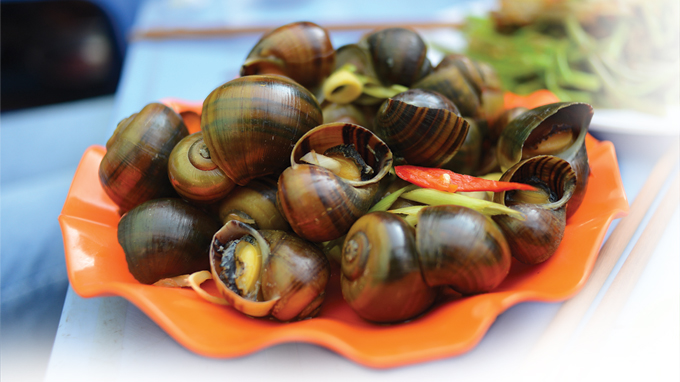Shellfish has long been a well-loved snack and delicacy for Vietnamese, appealing to local gourmands and tourists alike.
On weekends, Can Thanh Town in the heart of Ho Chi Minh City's suburban Can Gio District, some 60km from the downtown area, is packed with shellfish collectors and dealers.
The area is home to such shellfish hot spots as Can Gio wholesale market, Hang Duong seafood market, Can Thanh fish port, and April 30 beach.
From rivers to markets
Can Gio District features a wide variety of shellfish from salt, brackish, and fresh waters. Apart from the businesses that cultivate shellfish at stationary sites on a large scale, most natural collectors are dependent on the rivers and tides.
One night on the April 30 beach, some thousand locals were seen raking for shellfish. The light of their torches glared in the night over a 2-3km stretch of water.
According to Kim Thanh, a shellfish dealer on the 30-4 beach, shellfish collectors/scavengers wait for the tides to retreat and then scour the beach for clams, oysters, mussels, and scallops during the five or six hours before the tides rise again.
"On good days I can purchase dozens of kilograms a day and up to 200kg at a time. With more than 10 dealers like me, the April 30 beach alone can yield many tons of shellfish a day," Thanh said.
Phan Van Hieu, owner of Tu Hieu shop in Can Thanh Town, said that a household of two or three laborers can collect 5-7kg of shellfish and earn VND100,000-200,000 (US$4.8-9.5) a day.
According to Chin Liem, head of the Hang Duong market management, the market houses over 40 seafood stalls, which mostly offer shellfish to tourists and sell them in bulk to shops in HCMC.
Within only a few hours, a large portion of the shellfish is brought to the Binh Dien wholesale market in HCMC's suburban Binh Chanh District, which sells aquatic products and seafood from other provinces.
The shellfish at the Binh Dien market fetch slightly higher prices than in Can Gio. ‘Ngheu’ (clams) are sold for VND25,000-35,000 ($1.2-1.7) per kg, ‘hau’ (mussels) for VND16,000-25,000 ($0.8-1.2) per kg, and ‘oc len’ and ‘oc mo’ (different kinds of snails) for VND100,000-150,000 ($4.8-7.1) per kg.
The market is home to 442 seafood stalls, which supply roughly 1,000 tons of produce, including some 200 tons of shellfish, to HCMC residents on average per day, Nguyen Dang Phu, vice director of Binh Dien, said.
At Binh Dien from midnight until 3:00 am, many sacks of shellfish weighing some 100-120kg are loaded onto trucks and transported to inner city markets.
The trucks are packed with saltwater and ice to ensure the shellfish stay as fresh as possible, for fresh mollusks make an aromatic, richly flavored snack that is perfectly textured, neither too hard nor too tender.
Into sidewalk stalls, eateries, restaurants
In the past decades, several HCMC eateries have become famous for their signature shellfish dishes.
These include ‘oc gao’ (‘rice’ snails) shops on Ky Dong Street in District 3, ‘chem chep’ (a type of mussel) stores on Ben Chuong Duong Street in District 1, ‘oc len xao dua’ (snails stirred with coconut sauce) eateries on Ho Hao Hon Street in District 1, and ‘oc dua bo cay’ (‘coconut’ snails served with spicy butter) shops on Le Van Sy Street in District 3.
The well-loved snack is also widely available at numerous sidewalk stalls, particularly at night, when clients relish the mollusks over beer.
A number of foreigners have gone from surprise to delight at the delicacy and soon become faithful patrons of the stalls.
The mollusks are boiled, steamed, baked, and stirred tastily, and awaken all the senses when eaten.
Essential to the taste and texture of the mollusks is the preliminary cleaning process, unique for each type of shellfish. Shellfish should be properly prepared, cleaned, and preserved as they may carry parasites, according to Bui Thi Suong, vice chair of the Saigon Professional Chef Association.
Due attention should be taken to make sure that baked ‘oc nhay’ (‘hopping’ snails) are cleansed of all sand particles, that "oc dua" (‘coconut’ snails) are intact and have part of their shells in their mouths, and that ‘so duong’ (a kind of scallop) do not smell unpleasant.
Skilled cooks have their own secrets to keep the snails' internal organs intact even when they have been pulled out of their shells.
On Thanh Thai, known as a “snail street” in District 10, several large shops boast tanks containing live mollusks.
Such shops can also be found on District 1's Tran Hung Dao Street, which used to be one of the city's hot spots for mollusks.
Some hundred mollusk shops line Vinh Khanh, Hoang Dieu, and Ton Dan Streets in District 4.
These roadside eateries greatly appeal to Western backpackers as well as tourists from other Asian countries.
Shops on the expanded section of D2 Street and Ung Van Khiem Street in Binh Thanh District have recently offered new services, including snail buffets.
Large coal stoves are placed at the front of the shops, luring in pedestrians with the pervasive and irresistible smell of the cooking mollusks.
In recent years, the rustic delicacy has also made its way to restaurants and shops frequented by office workers at lunchtime.
The mollusks there are mostly prepared with Western recipes, such as ‘ngao’ (a kind of clam) steamed with milk, ‘hau’ (oysters) baked with butter and garlic, and snails specially prepared with cheese or steamed with wine, offering novel and delectable tastes.
Mollusks are preferred by clients partly because they are relatively safe for human consumption and are beneficial to one’s health, as they contain a high concentration of calcium. There is also a wide variety of shellfish to choose from, including new types imported from Thailand, Taiwan, and Canada.
A dish of snails generally fetches some VND40,000-55,000 ($1.9-2.6).
Some are offered for VND30,000-120,000 ($1.4-5.7) apiece while more expensive ones sell for at least VND580,000 ($27.6) per kg.


















































